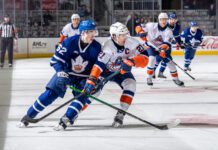There has been lots of love lately for the stellar play of Morgan Rielly and his partnership with free agent signing Ron Hainsey.
I had reservations about the Ron Hainsey signing as a defensive defenceman, as did others. I’ve also questioned how well Rielly’s skill set will mesh with the direction the NHL is heading as far as the changing role of the puck-rushing defenceman.
So far, the addition of Hainsey and his partnership with Rielly has given off a bit of a Gardiner/Phaneuf vibe; Hainsey takes care of a lot of the initialization and allows Rielly to transition, like Phaneuf would for Gardiner. The results so far have been incredible: Rielly has racked up 13 points, including five on the power play, an area he has really excelled in this season. Hainsey is tied for first among NHL defencemen in even strength assists with nine.
Natural Stat Trick recently unveiled a new tool that allows us to find teammates on the ice during an individual player’s 5v4 time. For Rielly, he is second among Leafs defencemen in power play time on ice, slightly behind Jake Gardiner. Note the difference in Rielly’s time spent with the Nazem Kadri, James van Riemsdyk and Tyler Bozak unit versus the limited time with Auston Matthews unit:
| Player 1 | Player 2 | Player 3 | Player 4 | GP | TOI | CF/60 | SF/60 | On-Ice SH% |
|---|---|---|---|---|---|---|---|---|
| Morgan Rielly | Nazem Kadri | James van Riemsdyk | Tyler Bozak | 16 | 31.92 | 146.63 | 88.36 | 14.89 |
| Morgan Rielly | Auston Matthews | William Nylander | 16 | 2.13 | 112.5 | 112.5 | 25 |
At 5v5, using this tool, we can isolate the impact of Auston Matthews with and without the pairing on the ice. The type of goaltending the pairing has been receiving when Matthews isn’t on the ice is in stark contrast to the type of goaltending they’re getting with Matthews on the ice. An .840 on-ice save percentage while controlling 54% of the shot attempts may be a reflection of the pairing and some of Frederik Andersen’s play.
| Player 1 | Player 2 | Player 3 | GP | TOI | CF% | GF% | On-Ice SH% | On-Ice SV% | PDO |
|---|---|---|---|---|---|---|---|---|---|
| Morgan Rielly | Ron Hainsey | Auston Matthews | 16 | 54.18 | 52 | 66.67 | 15 | 92 | 1.073 |
| Morgan Rielly | Ron Hainsey | w/o Auston Matthews | 17 | 168.07 | 54 | 45.45 | 11 | 84 | 0.954 |
The disparity fits the narrative of the Leafs this season: Fantastic while Matthews is on the ice and less than stellar without. The Rielly – Hainsey pairing has spent 24% of their 5v5 play with the Leafs‘ best player, and they share one lone assist with Rielly this season.
Puck Rushing Defencemen
One element in need of further study is the impact of the puck rusher’s skillset among NHL blueliners. I’ve touched on this theory before, and I don’t want to bog you down in minutiae here. In summary, defencemen that can make solid outlet and stretch passes may hold more value in the future by eliminating the need for rushers to do the heavy lifting of lugging pucks to centre. Instead, the focus is on supporting the rush, with the freedom to jump in from the defensive zone and even lead if the situation arises.
When the importance of the neutral zone was identified — underlining the importance of working the line to limit controlled zone entries — it reduced a staple play of the old guard: the dump and chase. Defencemen at even strength often skated the puck up to the red line and fired it in, looking for the recovery from the forwards and strategizing around that.
Rielly is a natural puck rusher. He’s often the first to carry out it of the zone and skates the penalty killing forecheckers back to the blueline before the drop pass on the powerplay.
This rushing play to centre and dump-in is less common with teams using speed through the neutral zone to force controlled entries, with exceptions such as line changes or getting behind a stacked blueline to try to limit controlled entries.
Defensive Zone Dump Outs
The aerial flip out of the defensive zone is the new outlet pass.
— Gus Katsaros? (@KatsHockey) October 10, 2017
The Pittsburgh Penguins have made an art out of dumping pucks to centre ice and using their speedy forwards to force the play out there.
As far as the Leafs‘ affinity for dumping pucks out of the defensive zone, Anthony Petrielli pointed this out last season and is apparent once again in 2017-18. I think this is also a functional effect of how teams were approaching icing — pucks are placed in the offensive zone but not across the goal line. Slightly altering this strategy, teams don’t dump it all the way down the ice; they dump it to centre, force battles in neutral territory and create races with speedy skilled forwards against pivoting defencemen. The Leafs use the long stretch plays on occasion.
“Rovers” are now more commonplace. Defencemen who can contribute play as hybrid forwards are replacing puck rushers, and rightly so. The fluidity to manoeuvre within system structure and take up temporary positions is paramount in the future game. Traditional rushing skills are replaced by mobility to support the rush and the ability to jump into the play to hit the opposition blueline four players strong (or as a close trailer). All are strong Rielly traits – especially if there’s defensive support, which Hainsey seems to be offering.
The ability to play within the first two or three feet inside the opposition blueline is an important skill and another Rielly quality – once again supported by Hainsey as the defensive conscious. Different individual skills are needed here such as reading emerging plays and being proactive under immediate pressure, keeping the play onside, and pinching from the line to force plays deeper into the zone with proper support. Only elite defenders really take advantage of the rushing skills, and not everyone can be Erik Karlsson.
Rielly has a unique ability to be able to skate the puck up ice, gain the zone, and make a play. In junior with the Moose Jaw Warriors, Rielly wasn’t playing among the most gifted forward group and often had to do it all himself. In the WHL, he was able to move it, gain the zone, and create.
In the NHL, often that play degenerated into a lone-ranger rush. Attempting to do it on his own would fizzle, unlike in developmental leagues. The optics have been mixed for me. Plays that seemed to be good enough for a scoring chance made the case for continued rushes up ice, but most of the time the lone-ranger rushes ended with a thud.
In 2017-18, however, he’s been able to strike a balance between involvement and individualism. He has also been stellar at the top of the offensive zone.
While the defensive game is still a work in progress, Rielly emerging as another offensive threat alongside Jake Gardiner makes the Leafs blueline more dangerous.
I’m glad that some of the fears I harboured about Rielly have been allayed with a great first quarter. The hope is that he can build off of this structure and continue to perform at such a high level should the Leafs coaching staff try some different tactics to alleviate the defensive leaks – and the rash of inconsistent goaltending of late.


































